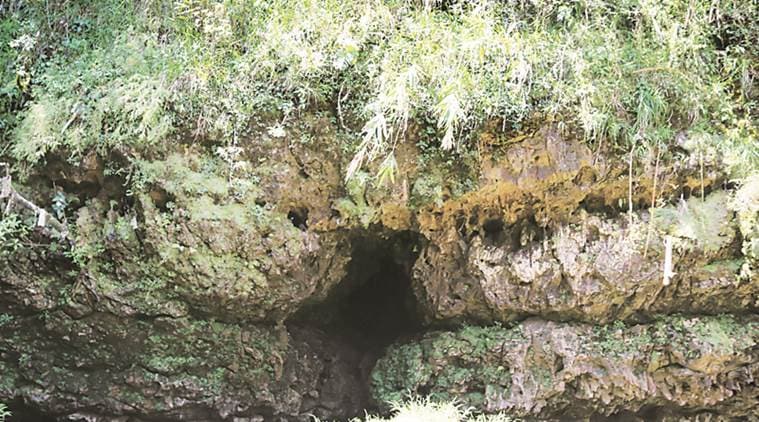 A 7.2-km-long cave, almost hidden behind an imposing cement factory, and a trek of 10-odd minutes from the nearest motorable road, part of it wading through a stream, just attained a permanent spot in the study of Earth’s geological history.
A 7.2-km-long cave, almost hidden behind an imposing cement factory, and a trek of 10-odd minutes from the nearest motorable road, part of it wading through a stream, just attained a permanent spot in the study of Earth’s geological history.
But even at Mawmluh, a small village tucked away in the East Khasi Hills district of Meghalaya, unless you ask around, it’s not easy to find the cave. Unlike its popular counterpart Mawsmai cave — located around 7 km away and open to visitors — the Mawmluh cave cannot be entered without expert guidance.
The International Union of Geological Sciences recently announced the division of the last 11,700 years on the geological time scale into three parts: the Lower Holocene or Greenlandian Age, the Middle Holocene or Northgrippian Age, and the Upper Holocene or Meghalayan Age.
The Meghalayan Age started 4,200 years ago, when agricultural societies around the world experienced a mega-drought. The time period of the beginning of the Meghalayan Age is defined at a specific level in a stalagmite specimen collected from the Mawmluh cave. Meghalaya has an extensive network of caves, attributed by scientists to the significant limestone bedrock omnipresent in the region. The Mawmluh specimen provided the best record of the climate at that time to the researchers.
Lying adjacent to the tourist hot-spot of Cherrapunjee, the Mawmluh village of 230-odd families is more known for the Mawmluh-Cherra Cements Limited (MCCL) cement factory. The first such factory in the Northeast, established in the 1960s, its towering structure dominates the village’s landscape.
The man who helped the geological scientists zero in on the little-known Mawmluh cave was Brian Karpran Daly. The 71-year-old is unanimously acknowledged as the foremost cave enthusiast and explorer in Meghalaya, credited with discovering, exploring and mapping 1,700-odd caves in the state.
Daly, who first explored the Mawmluh cave in the early 1990s, says its existence has been known since the British period. “Mawmluh is a cave of international standards. It is a big cave, and it has got a bit of everything — it has got water flowing into it, it has a pool, it has got numerous passages, it has beautiful formations inside. If people want to explore a cave, I generally take them to this one. It has got almost everything that the other caves have.”
In 1990, Daly had founded the Meghalaya Adventurers Association (MAA), a group of caving enthusiasts, and won the Tenzing Norgay National Adventure Award for Land Adventure in 2002. He is also the chairperson of the Shillong Co-operative Urban Bank.
When the researchers behind the geological study first came in 2003 to get stalagmite specimens, Daly says, he took them to Mawmluh too. Asked how they zeroed in on the cave, scientist Dr Max Berkelhammer, an assistant professor at the University of Illinois, Chicago, who worked on the specimen, said on email, “The choice to work in this region was because of these two reasons — firstly, the presence of so many cave systems and secondly, the fact that this region is a critical indicator of the overall strength of the Indian monsoon. Therefore, studying the history of the monsoon from this region sheds light on the overall history of the monsoon.”
Dr Berkelhammer said the specimen from Mawmluh, along with a handful of others from Meghalaya, “provided a history of the monsoon throughout the Holocene period”. “This history enabled us to recognise and document the extraordinary changes in the monsoon system about 4,000 years ago.”
According to Daly, any person going to explore the Mawmluh cave needs a caving suit to keep one warm and protect the body as one has to crawl through part of it, strong boots and a helmet with a light attached for illumination.
Mawmluh villagers are aware of their new-found fame, with the geological study also reported in the local press. Aware that it the cave may soon become a tourist destination, like other caves in the state, Daly says, “For economic benefit, some caves have been turned into ‘show caves’ with proper lighting and other facilities for tourists. But not all caves can be converted like that because caves are meant to be preserved. They are natural scientific resources.”
One of the primary concerns regarding the Mawmluh cave is that the MCCL mines for limestone in the surface above it, which experts like Daly says can cause its collapse. “Mining has been going on for the last 60 years. I have been writing letters and complaining. Mining limestone can not only damage the cave but make it extinct. My suggestion is bring limestone from another area for the MCCL,” says Davy.
Preinsingh Lyngdoh, the ‘sirdar’ (the local chief) of Mawmluh, says, “We have already written to the management of the MCCL to ensure that no damage happens to the cave. We have decided to meet the Managing Director now, after this scientific research.”
East Khasi Hills Deputy Commissioner P S Dkhar says the government has taken note of the development. “After this great news, the government and administration have to look at preservation of caves in a serious way,” he says.